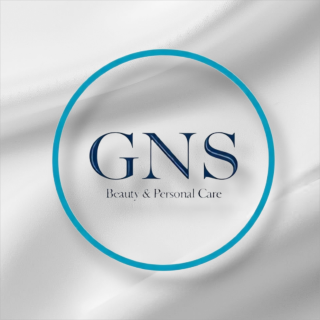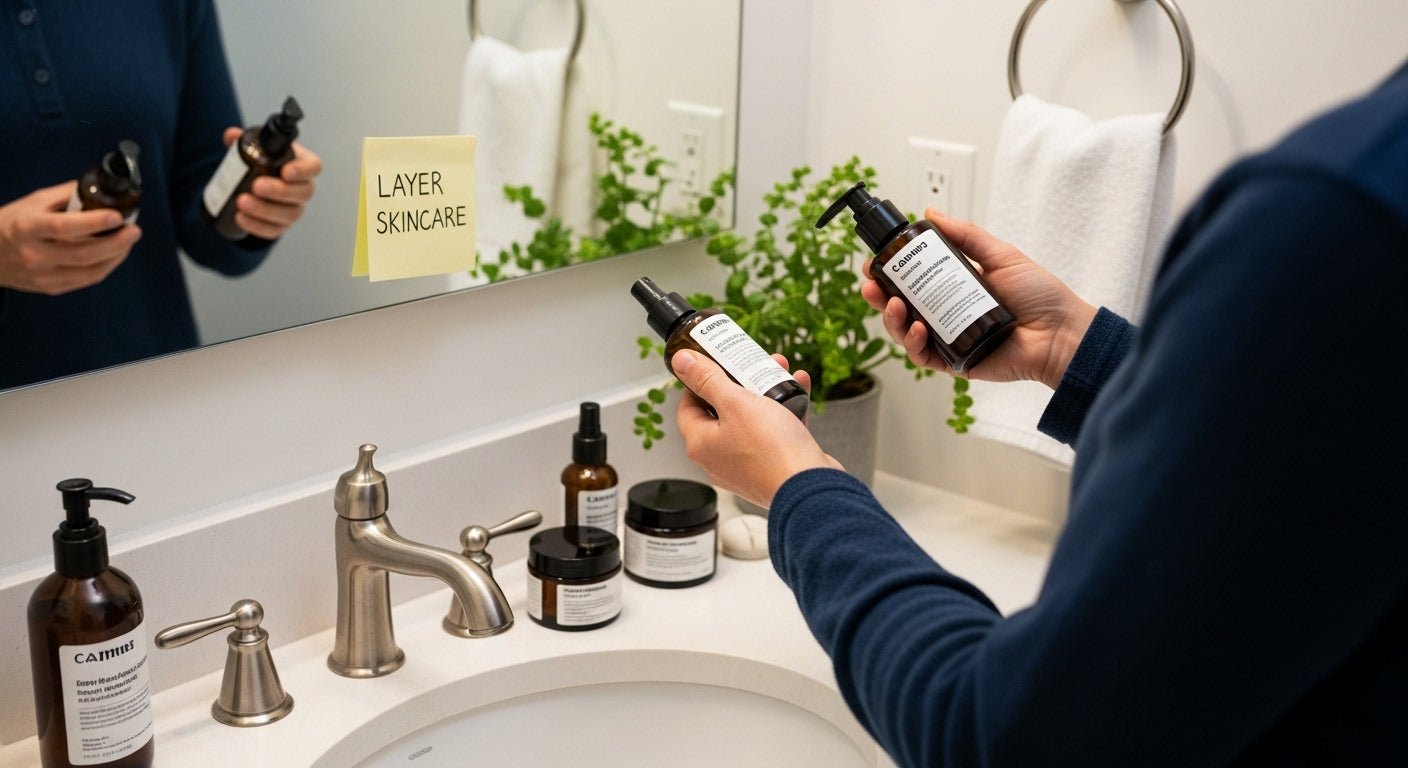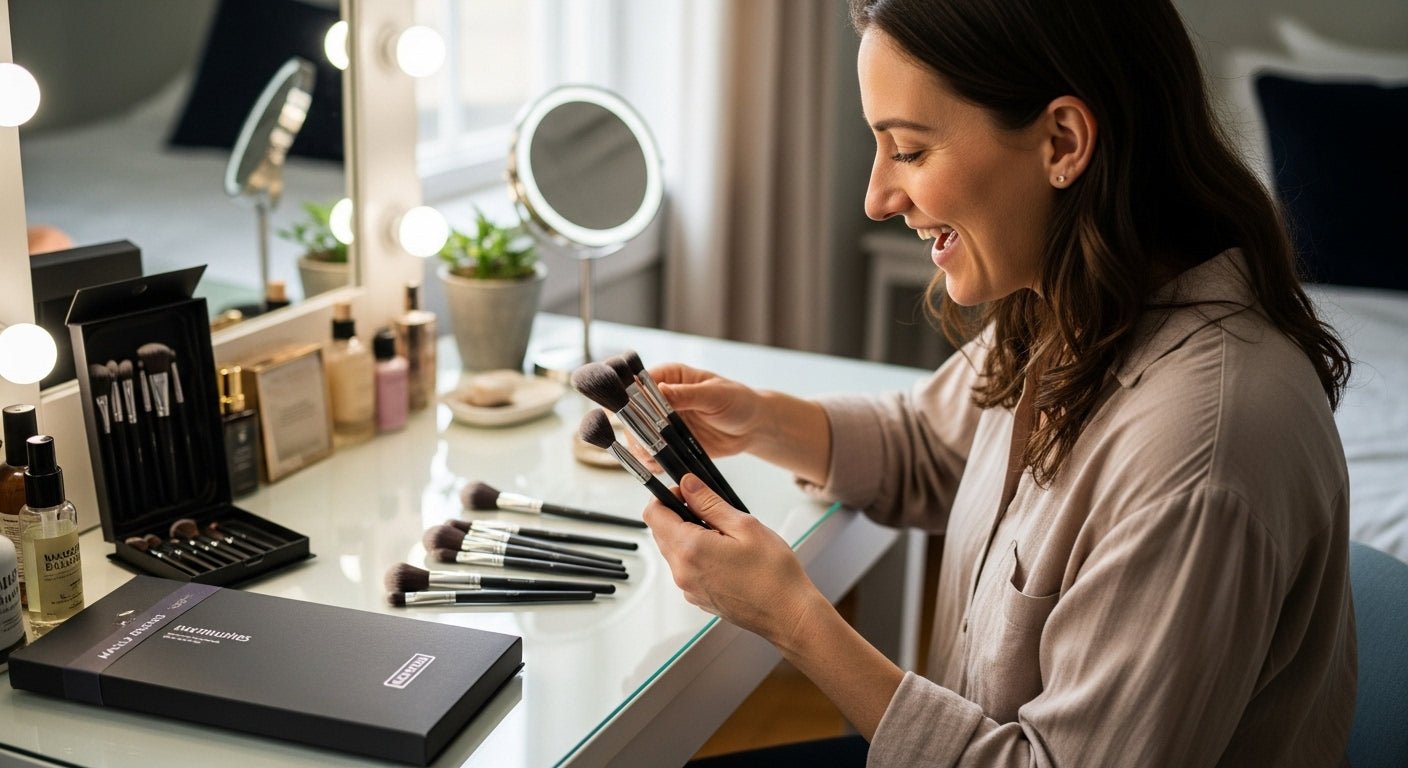Skincare routines are everywhere and everyone swears by their own step-by-step system. You might think slathering on layers of products will do the trick, but research shows that over 50 percent of people use the wrong products for their skin type, leading to irritation instead of improvement. Turns out, choosing and applying your products with precision matters way more than doubling up on fancy bottles.
Table of Contents
- Step 1: Identify Your Skin Type And Concerns
- Step 2: Choose The Right Products For Your Routine
- Step 3: Establish A Layering Order With Correct Consistency
- Step 4: Apply Products Using Proper Techniques
- Step 5: Monitor Results And Adjust As Needed
Quick Summary
| Key Point | Explanation |
|---|---|
| 1. Identify your skin type first | Assess your skin type and concerns to tailor your skincare routine effectively and avoid adverse reactions. |
| 2. Choose ingredients over brands | Focus on scientifically backed active ingredients tailored to your skin needs rather than marketing claims. |
| 3. Layer products from light to heavy | Apply lighter, water-based products first, working up to heavier creams for maximum absorption and efficacy. |
| 4. Use gentle application techniques | Employ light pressure and patting motions to enhance absorption and minimize skin irritation during application. |
| 5. Monitor and adjust your routine | Keep track of your skin’s responses and be flexible in adapting your regimen as needed to maintain optimal skin health. |
Step 1: Identify Your Skin Type and Concerns
Successful skincare layering begins with understanding your unique skin profile. Before investing time and resources into multiple products, you need a clear comprehension of your skin type and specific concerns. This foundational step determines how effectively your skincare routine will address individual needs and prevent potential adverse reactions.
Your skin type represents a critical baseline for product selection. Typically, skin types fall into five primary categories: normal, dry, oily, combination, and sensitive. Determining your type requires careful observation and simple at home assessment techniques. Start by thoroughly cleansing your face and waiting one hour without applying any products. Observe how your skin feels and appears.
For dry skin, you might notice tightness, flakiness, and potential visible fine lines. Oily skin presents with visible shine, enlarged pores, and potential acne prone areas, particularly around the forehead, nose, and chin. Combination skin exhibits characteristics of both dry and oily types, with some areas appearing greasy while others remain parched. Sensitive skin tends to react quickly to new products, displaying redness, irritation, or sudden breakouts.
Beyond identifying your basic skin type, pinpointing specific skin concerns is equally crucial. These might include hyperpigmentation, acne, premature aging, uneven texture, or dehydration. Each concern requires targeted approaches and specific ingredient combinations. According to research from the International Journal of Women’s Dermatology, precise skin assessment allows for more personalized and effective skincare strategies.
To verify your skin assessment, consider consulting a dermatologist for professional analysis. Alternatively, use these verification markers:
- Skin feels consistently comfortable without tightness or excessive oiliness
- No frequent breakouts or persistent irritation
- Products absorb easily without causing adverse reactions
Understanding your skin thoroughly sets the stage for constructing a targeted, effective skincare layering routine that addresses your unique needs with precision and care.
Below is a comparison table summarizing the five main skin types described in the article, highlighting their common characteristics and indicators to help readers identify their own skin type more easily.
| Skin Type | Main Characteristics | Typical Indicators |
|---|---|---|
| Normal | Balanced, comfortable, neither oily nor dry | No tightness or excessive oiliness |
| Dry | Lacks moisture, may feel tight or flaky | Tightness, flakiness, fine lines |
| Oily | Excess oil production, shiny appearance | Visible shine and enlarged pores |
| Combination | Mix of oily and dry areas on the face | Greasy T-zone, dry cheeks |
| Sensitive | Easily irritated, reactive to new products | Redness, irritation, breakouts |
Step 2: Choose the Right Products for Your Routine
Selecting the right skincare products transforms your routine from a generic approach to a personalized strategy targeting your specific skin needs. After identifying your skin type and concerns, product selection becomes a nuanced process of matching ingredients, textures, and formulations to address your unique dermatological profile.
Begin by creating a foundational routine that includes core product categories: cleanser, toner, serum, moisturizer, and sunscreen. Each product should complement your skin type and work synergistically to enhance overall skin health. For instance, dry skin requires richer, more hydrating formulations, while oily skin benefits from lightweight, non comedogenic products that control excess sebum production.
When evaluating potential skincare products, ingredient composition matters significantly more than brand marketing. Look for scientifically backed active ingredients tailored to your specific concerns. Hyaluronic acid works wonderfully for hydration, niacinamide helps regulate oil production, vitamin C brightens complexion, and ceramides support skin barrier function. According to research in the International Journal of Women’s Dermatology, evidence-based ingredient selection can dramatically improve skincare efficacy.
Consider your skin’s sensitivity and potential reactivity when introducing new products. Implement a patch test by applying a small amount of product on your inner forearm and monitoring for 24-48 hours for any adverse reactions.
Start with one new product at a time, allowing your skin adequate adjustment periods between introductions. This methodical approach helps identify specific ingredients causing potential irritation and prevents overwhelming your skin’s natural balance.
To verify you’ve successfully chosen appropriate products, observe these key indicators:
- Products feel comfortable and absorb easily into your skin
- No persistent redness, burning, or unexpected breakouts
- Skin appears more balanced and responds positively within 2-4 weeks of consistent use
Remember that skincare is a journey of continuous learning and adaptation. Your skin’s needs will evolve with age, environmental factors, and lifestyle changes, so remain flexible and willing to adjust your product selection accordingly.
Step 3: Establish a Layering Order with Correct Consistency
Mastering the art of skincare layering requires understanding the fundamental principle of product consistency and strategic application. Your goal is to create a systematic approach that allows each product to penetrate effectively, maximizing absorption and minimizing potential interactions that could reduce overall efficacy.
Begin your routine with the lightest, most water-based products and progressively move towards heavier, more occlusive formulations. This approach ensures that each subsequent product can effectively reach deeper skin layers without being blocked by previous applications.
 Your morning routine will typically differ from your evening routine, with daytime layers focusing on protection and nighttime layers emphasizing repair and regeneration.
Your morning routine will typically differ from your evening routine, with daytime layers focusing on protection and nighttime layers emphasizing repair and regeneration.
A typical morning layering sequence starts with cleansing, followed by lightweight water-based treatments like toners or essences. Next, apply targeted serums containing active ingredients such as vitamin C or hyaluronic acid. These concentrated formulations deliver potent nutrients directly into the skin. After serums, apply a moisturizer to seal in hydration and create a protective barrier. Sunscreen becomes your final daytime layer, providing crucial protection against environmental damage.
Nighttime routines follow a similar principle but incorporate more intensive repair-focused products. After cleansing, you might introduce treatment products like retinols or chemical exfoliants that work best without competing with daytime environmental protectants. According to research exploring skincare product application, maintaining a consistent layering strategy significantly enhances product performance.
Pay special attention to potential product interactions. Active ingredients like retinol, vitamin C, and exfoliating acids can be destabilized or rendered less effective when combined incorrectly. Some powerful ingredients work best when applied separately or at different times of the day.
To verify you’ve successfully established an effective layering routine, observe these key indicators:
- Products absorb quickly without feeling heavy or greasy
- Skin appears hydrated and balanced throughout the day
- No unexpected irritation or breakouts occur

- Noticeable improvement in skin texture and appearance within 4-6 weeks
Remember that skincare is a personalized journey. While these guidelines provide a solid framework, be prepared to adjust your routine based on your skin’s unique responses and changing needs.
Step 4: Apply Products Using Proper Techniques
Successful skincare isn’t just about selecting the right products, but also mastering the precise techniques of application. The way you apply your skincare products can significantly impact their absorption, effectiveness, and overall performance. Your goal is to create a gentle, strategic approach that maximizes product potential while minimizing potential skin stress.
Cleansing and preparation set the foundation for optimal product absorption. Use lukewarm water to open pores and remove any residual oils or impurities. When applying products, use clean hands or soft, sanitized tools to prevent bacterial transfer. Avoid using excessive pressure or aggressive rubbing, which can cause micro-irritations and potentially damage your skin’s delicate surface.
Product application requires a specific touch. Gentle patting and pressing techniques allow products to penetrate more effectively compared to aggressive rubbing. Start from the center of your face and move outward in light, upward motions. This technique supports natural skin elasticity and promotes better product distribution. For serums and lighter treatments, use your ring finger when working around delicate eye areas to minimize unnecessary pulling or stretching of the skin.
Timing between product applications is crucial. Allow each layer approximately 30-60 seconds to absorb before applying the next. This waiting period ensures that active ingredients have sufficient time to penetrate the skin and reduces the risk of product pilling or ineffective absorption. According to research exploring skincare application techniques, proper application methodology can dramatically enhance product performance.
During daytime routines, pay special attention to sunscreen application. Apply sunscreen as the final step of your morning skincare routine, using approximately a quarter-sized amount to cover your entire face and neck. Use gentle upward strokes, ensuring complete and even coverage. Reapplication every two hours is recommended when exposed to direct sunlight.
To verify you’ve successfully applied your skincare products, check these indicators:
- Products feel smoothly absorbed without residue or greasiness
- Skin appears hydrated and radiant
- No visible product pilling or uneven texture
- Comfortable sensation without tightness or irritation
Remember that consistency and gentleness are key. Your skin responds best to patient, mindful application techniques that respect its natural balance and healing capabilities.
Step 5: Monitor Results and Adjust as Needed
Establishing an effective skincare routine is an ongoing process of observation, adaptation, and personalization. After implementing your carefully selected products and application techniques, the crucial next step involves systematically monitoring your skin’s response and being prepared to make informed adjustments.
Tracking changes requires consistent and mindful documentation. Consider maintaining a skincare journal where you record daily observations about your skin’s texture, hydration levels, potential breakouts, and overall appearance. Take clear, well-lit photographs of your skin at consistent intervals under similar lighting conditions. These visual and written records will help you objectively assess whether your current routine is delivering the desired results.
Pay close attention to how your skin reacts during the first four to six weeks of implementing a new routine. Subtle improvements might include increased skin smoothness, reduced visible pores, more balanced oil production, and enhanced overall radiance. Conversely, be vigilant about potential negative signals such as persistent redness, increased breakouts, unusual dryness, or unexpected sensitivity. These could indicate that certain products are not compatible with your skin or that your current approach needs refinement.
Some active ingredients require a gradual introduction to allow your skin to build tolerance. For instance, retinol and chemical exfoliants might initially cause mild irritation or slight peeling. According to research from Harvard Health, introducing these ingredients incrementally can help minimize adverse reactions while allowing your skin to adapt.
When assessing your routine’s effectiveness, consider external factors that might influence your skin’s condition. Seasonal changes, stress levels, dietary modifications, and hormonal fluctuations can all impact skin health. Be prepared to modify your routine accordingly, perhaps using lighter moisturizers during humid summers or introducing more hydrating products during dry winter months.
Use this checklist table to verify the effectiveness of your skincare routine based on the recommended monitoring steps, so you can easily track progress and identify if adjustments are needed over time.
| Verification Step | What to Look For |
|---|---|
| Skin consistency | Maintains healthy, even appearance |
| Irritation/reactivity | No persistent irritation or unusual breakouts |
| Skin texture & complexion | Gradual improvement in smoothness and overall tone |
| Comfort level | Feel confident and comfortable with your routine |
| Adaptation to changes | Able to adjust products based on seasonal/life factors |
| Visual documentation (photos/journal) | Noticeable improvements over 4-6 weeks |
To verify you’re successfully monitoring and adjusting your skincare routine, observe these key indicators:
- Skin maintains a consistent, healthy appearance without dramatic fluctuations
- No persistent irritation or unexpected breakouts
- Gradual improvement in skin texture and overall complexion
- Feeling confident and comfortable with your skincare approach
Remember that skincare is a personal journey. What works perfectly for someone else might not be ideal for your unique skin. Patience, careful observation, and willingness to adapt are your most valuable tools in creating a truly personalized skincare routine.
Elevate Your Skincare Routine With Tailored Essentials from GNS Beauty
You worked hard to decode your skin’s needs and learn the right way to layer products, but finding high-quality essentials that actually match your skincare goals can still be overwhelming. Common struggles include product overload, ingredient mismatches, and the frustration of not seeing visible results, all of which were covered in How to Layer Skincare Products for Maximum Benefit (The Beginner’s Guide). When you want to put your new layering knowledge to action, the last thing you need is to waste time sorting through hundreds of options that do not align with your skin type, personal values, or wellness routine.

Upgrade your skincare lineup and avoid guesswork by shopping the curated selections at GNS Beauty & Personal Care. You will discover eco-conscious, high-performance products tested for real results. Explore detailed product listings to target concerns from hydration and anti-aging to sensitive skin support, and enjoy an effortless shopping experience designed for people who truly care about self-care. Visit our website and build a routine that brings out your best skin faster. Start today to see a visible difference—because your skin deserves nothing less.
Frequently Asked Questions
How do I determine my skin type?
To determine your skin type, cleanse your face and wait for one hour without applying any products. Observe how your skin feels and appears:
- Dry skin may feel tight and flakey.
- Oily skin will have visible shine and enlarged pores.
- Combination skin has both oily and dry areas.
- Sensitive skin may react quickly with redness or irritation.
What is the correct order for layering skincare products?
Start with the lightest products and gradually move to heavier ones. A typical order is: cleanser, toner, serum, moisturizer, and sunscreen (for morning use). At night, you would use the same order but may include treatment products like retinols or exfoliants after cleansing.
How can I tell if my skincare products are working?
Monitor your skin’s response over 4-6 weeks. Look for improvements in texture and hydration, reduced breakouts, and overall balance. Maintain a skincare journal to document changes, and take photos to visually assess your progress.
What techniques should I use when applying skincare products?
Apply products using gentle patting and pressing motions, starting from the center of your face and moving outward. Allow each layer to absorb for 30-60 seconds before applying the next to ensure better penetration and efficacy.








Leave a comment
All comments are moderated before being published.
This site is protected by hCaptcha and the hCaptcha Privacy Policy and Terms of Service apply.